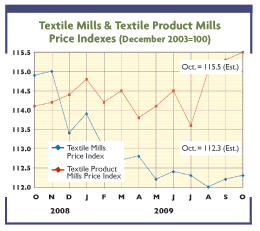N
ear-term textile and apparel trends could well depend on how the upcoming Christmas
season fares. Most of the predictions making the rounds these days suggest a basically flat pattern
over the next month or two – though a few, like the one from the National Retail Foundation, expect
some fractional declines.
Textile World
, however, is somewhat more positive — anticipating a small gain over last year’s numbers.
If
TW
is correct, it would be a considerable improvement over 2008, when November/December retail
sales dropped 3.4 percent. Part of
TW
‘s optimism is based on the fact that consumer confidence is now significantly higher than it
was just a few months ago. Adding to this confidence is the fact that pay from wages and salaries
has turned upward for the first time in nearly a year. Still another reason to expect a buying
pickup: Households have managed to recover more than $4 trillion in recession-lost net worth over
the past two quarters — thus recouping a modest percentage of the $14 trillion lost during the
previous year or so. Last, but not least, clothing is expected to do a bit better than other goods
during the 2009 gift season — primarily because consumers are still wary about making purchases of
more expensive items. Throw all of the above into the computer hopper, and there would seem to be
little reason to anticipate further textile/apparel declines. Indeed,
TW
‘s equations suggest the bottoming out in both mill production and shipments noted over the
past six months will continue, hopefully setting the scene for an improved 2010.

Employment
A less rosy picture is seen when it comes to industry jobs, which should continue to shrink.
Much of the worker decline over the past few years can be traced to the big slide in mill activity.
But another part simply reflects increasing productivity. As such, even with the expected leveling
off in mill activity projected over the next few years, the number of industry employees is
expected to continue shrinking. One recent long look ahead by the Bureau of Labor Statistics
projects a 2.75-percent annual rate of employment decline in the basic textile mill sector over the
10-year period ending in 2016. The rate of decline in the more highly fabricated textile product
sector over the same period of time — though at a lower 1.25-percent annual rate — can also be
considered significant. It means the overall US industry workforce, which has been more than halved
since 2000, will continue to contract. But, as pointed out previously, there is a brighter side to
all this. Specifically, the increasing productivity factor noted above, along with only minimal pay
increases – expected to average in the low 2- to 3-percent range over the next few years — will
continue to reduce unit labor costs, and in the process help keep the US industry competitive in
today’s one-world textile/apparel market.
Cotton Prices
Calling the turn on cotton quotes may be a bit easier now. That’s because the US Department
of Agriculture (USDA) has removed its long-term ban on forecasting prices of this key natural
fiber. In fact, the agency’s economists have developed a new mathematical model that predicts
prices on the basis of changes such as variables in US and global supply/demand factors,
macroeconomic developments and global policy shifts. Some of the model’s findings: A 1-percent
increase in US supply from the previous year will cause US cotton tags to drop about 0.9 percent in
real terms; changes in foreign supply affect US prices on a nearly one-to-one basis, with quotes
falling as supply rises; a 1-percent increase in end-of-season stocks covered by the government’s
loan program, with stocks measured as a proportion of US cotton use, raises tags by 0.4 percent;
and a 1 million-bale increase in China’s net imports raises prices by 3.1 percent. More detailed
information on the model is available at
www.ers.usda. gov/publications/err80.
While the USDA has not as yet published any overall price forecast, an already-existing model
developed by the International Cotton Advisory Committee (ICAC) suggests a slight price rise may be
in the making for the 2009-2010 marketing year. Specifically, the ICAC model, noting a 1-percent
expected decline in global supplies, suggests a current year’s price advance of about 5 percent.
But that would still leave tags well under recent peaks.
November/December 2009




